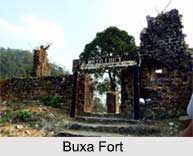 Buxa Fort is one of the most popular tourist destinations for the visitors in Buxa Tiger Reserve in West Bengal. It is situated at the height of 2844 feet above the sea level and offers the thrill along with the experience for the trekkers. Buxa Fort is one of the earliest forts in Eastern India.
Buxa Fort is one of the most popular tourist destinations for the visitors in Buxa Tiger Reserve in West Bengal. It is situated at the height of 2844 feet above the sea level and offers the thrill along with the experience for the trekkers. Buxa Fort is one of the earliest forts in Eastern India.
Location of Buxa Fort
Buxa Fort is located at the Buxa Tiger Reserve of Jalpaiguri district in West Bengal. It is located 30 kilometres (19 mi) from Alipurduar region, the nearest town. It is situated on the trek of the West Bengal-Bhutan border.
History of Buxa Fort
Buxa Fort links to the imposing history of India. The fort might have been first built either by the Tibetan Occupation Forces in the middle or in the second half of the seventh century or by Sangaldwip, the first ruler of Kamatapur Empire. In subsequent times, the Koch kings had taken possession of the fort before it was seized by the Bhutanese in the second half of the 18th century. The Bhutan King used the fort to protect the portion of famous Silk Route connecting Tibet with India.
Buxa Fort, for its origin might have had connection with the Tibetan occupation army in North-Eastern India since the time of Tsong-sen-Gyampo, the Tibetan Emperor. It is notable that the Tibetans first made stone bridge across the Tista River. The alternative finding is that the fort might have been constructed by King Sangaldwip, the first ruler of Kamatapur in the second half of the seventh century. Sangaldwip had the urgency of expelling the Tibetans from India. Buxa fort had been long under the possession of the Koch kings before it was occupied by the Bhutanese who used it as a garrison to guard the trade route that passed through this area. Before the occupation of the fort by the British, it was a point of contention between the King of Bhutan and the Koch Kings.
The British on invitation of the Koch King intervened and captured the fort which was formally handed over to the British on November 11, 1865 as part of Treaty of Sinchula. The British reconstructed the fort from its bamboo wood structure to stone structure. The fort was to be later used as a high security prison and detention camp in the 1930s. It was the most notorious and unreachable prison in India after the Cellular Jail in Andaman.
In the year 1966, the Indian Ministry of External Affairs was alerted to the conditions of the Buxa refugee camps, and it became apparent that the Tibetan refugees would have to be relocated to a more hospitable place. Initially reluctant, a message from the Dalai Lama, urging them to think of the future and to strive for sufficiency, and the option of settling near other Tibetan refugees convinced the monks to move, and in 1971 the monks moved to their new locations at Bylakuppe and Mundgod in the state of Karnataka.
Things to do in Buxa Fort
There are number of beautiful trekking routes start from Buxa Fort. From Santalabari to Buxa Fort is 5 kilometres, Buxa Fort to Rovers point is 3 kilometres, Santalabari to Roopang valley is 14 kilometres, Buxa Fort to Chunabhati is 4 kilometres etc. Another small but beautiful valley called Lepchakha can be reached from Buxa fort by 5 kilometres trekking. Lepchakhawa presents a wonderful view of complete Buxa Tiger Reserve, plains of North Bengal and neighbouring Bhutan.






